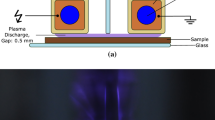Abstract
Barley leaves in point to plane electrode configuration were exposed to high electrical fields. The amount of tip damage was observed for various voltages and exposure times. Damage appears to be due exclusively to I2 Rt energy dissipated in the leaf. The damaging current is comprised of contributions from brush discharge and corona glow. Ozone and other corona byproducts contribute little or nothing to the tip damage.
Zusammenfassung
Gerstenblätter angebracht zwischen flachen Elektroden wurden hohen elektrischen Feldern ausgesetzt und das Ausmass der Spitzenschädigung bei verschiedenen Spannungen und Belastungszeiten bestimmt. Der Schaden scheint ausschliesslich Folge der I2 Rt Energie zu sein, die sich in die Blätter verteilt. Der schädigende Strom besteht aus Beiträgen von Bürstenentladungen und Coronaglühen. Ozon und andere Corona-Nebenprodukte tragen wenig oder nichts zur Schädigung der Spitzen bei.
Resume
On a placé des feuilles d'orge entre des électrodes plates et on les a soumises à des champs électriques à haute intensité afin de déterminer l'importance des dégâts causés à la pointe des feuilles par des tensions et des temps de contrainte différents. Les dégâts semblent être exclusivement le résultat de l'énergie I2Rt qui se répand dans la feuille. Le courant destructeur se divise en deux contraintes: les décharges en forme de brosse et l'incandescence de la couronne. La présence d'ozone ou d'autres produits auxiliaires de la couronne ne contribue que peu -voire pas du tout- aux dommages encourus par la pointe des feuilles.
Similar content being viewed by others
References
BACHMAN, C.H., HADEMENOS, D.G. and UNDERWOOD, L.S. (1971): Ozone and air ions accompanying biological applications of electrical fields. J.Atmosph.Terr.Phys., 33: 497–505.
COBINE, J.D. (1941): Gaseous Conductors. McGraw Hill Book Co., New York, 167.
DEVONS, J.C. (1956): Mechanism of ozone formation in the silent electric discharge. J.Electrochem.Soc., 103: 460–466.
HART, F.X. and BACHMAN, C.H. (1968): The effect of air ions on liquid evaporation rates. Int.J.Biometeor., 12: 251–261.
MILLER, E.C. (1938): Plant Physiology. McGraw Hill, New York, 1085 pp.
MURR, L.E. and HODGKIN, N.M. (1970): Scanning Electron Microscope Studies of plant-leaf damage in an electrostatic field. Proc. 3rd Annual Scanning Electron Microscope Symposium IIT Research Inst., Chicago, Ill.: 154–160.
SHLANTA, A. and MOORE, C.B. (1972): Ozone and point discharge measurements under thunderclouds. J.Geophys.Res., 77: 4500–4510.
Author information
Authors and Affiliations
Rights and permissions
About this article
Cite this article
Bachman, C.H., Reichmanis, M. Barley leaf tip damage resulting from exposure to high electrical fields. Int J Biometeorol 17, 243–251 (1973). https://doi.org/10.1007/BF01804617
Received:
Issue Date:
DOI: https://doi.org/10.1007/BF01804617




